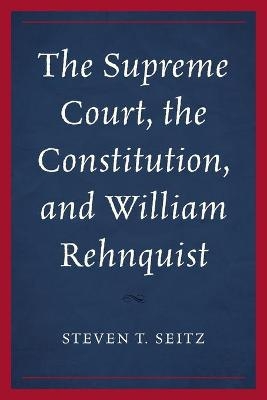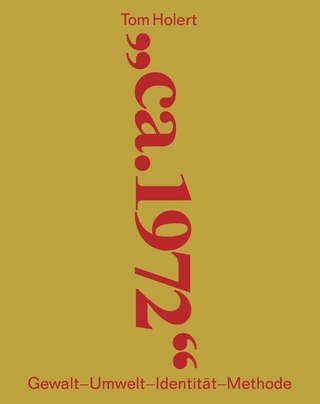
The Supreme Court, the Constitution, and William Rehnquist
Seiten
2020
Lexington Books (Verlag)
978-1-4985-6884-5 (ISBN)
Lexington Books (Verlag)
978-1-4985-6884-5 (ISBN)
This book examines the rich detail underlying the powers and limits of Supreme Court decision-making, from the heady days of John Marshall through the closure of the Rehnquist era. The book investigates several enabling clauses and several limitations imposed through rules of justiciability.
The Founding Fathers wrote the Constitution at a level sufficiently general to guide lawmaking while avoiding great detail. This four-page document has guided the United States of America for more than two centuries. The Supreme Court has parsed the document into clauses, which plaintiffs and defendants invoke in cases or controversies before the Court. Some, like the Interstate Commerce Clause, are central to the survival of a government of multiple sovereignties. The practice of observing case precedents allows orderly development of the law and consistent direction to the lower courts. The Court itself claimed the final power of judicial review, despite efforts to the contrary by the executive and legislative branches of the national government and the state supreme courts. The Court then limited its own awesome power through a series of self-imposed rules of justiciability. These rules set the conditions under which the Court may exercise the extraordinary final power of judicial review. Some of these self-imposed limits are prudential, some logical, and some inviting periodic revision. This book examines the detailed unfolding of several Constitutional clauses and the rules of justiciability. For each clause and each rule of justiciability, the book begins with the brilliant foundations laid by Chief Justice John Marshall, then to the anti-Federalist era, the Civil War, the dominance of laissez faire and social Darwinism, the Great Depression redirection, the civil rights era, and finally the often-hapless efforts of Chief Justice Rehnquist.
The Founding Fathers wrote the Constitution at a level sufficiently general to guide lawmaking while avoiding great detail. This four-page document has guided the United States of America for more than two centuries. The Supreme Court has parsed the document into clauses, which plaintiffs and defendants invoke in cases or controversies before the Court. Some, like the Interstate Commerce Clause, are central to the survival of a government of multiple sovereignties. The practice of observing case precedents allows orderly development of the law and consistent direction to the lower courts. The Court itself claimed the final power of judicial review, despite efforts to the contrary by the executive and legislative branches of the national government and the state supreme courts. The Court then limited its own awesome power through a series of self-imposed rules of justiciability. These rules set the conditions under which the Court may exercise the extraordinary final power of judicial review. Some of these self-imposed limits are prudential, some logical, and some inviting periodic revision. This book examines the detailed unfolding of several Constitutional clauses and the rules of justiciability. For each clause and each rule of justiciability, the book begins with the brilliant foundations laid by Chief Justice John Marshall, then to the anti-Federalist era, the Civil War, the dominance of laissez faire and social Darwinism, the Great Depression redirection, the civil rights era, and finally the often-hapless efforts of Chief Justice Rehnquist.
Steven T. Seitz is associate professor of political science at University of Illinois at Urbana–Champaign.
Preface
Chapter 1: State Sovereignty
Chapter 2: Full Faith and Credit
Chapter 3: Privileges and Immunities
Chapter 4: Interstate Commerce Clause
Chapter 5: The Administrative State
Chapter 6: Justiciability and Habeas Corpus
Chapter 7: Standing, Ripeness, Political Question
Chapter 8: Federal Question
Works Cited
Cases Cited
| Erscheinungsdatum | 10.05.2021 |
|---|---|
| Verlagsort | Lanham, MD |
| Sprache | englisch |
| Maße | 154 x 218 mm |
| Gewicht | 431 g |
| Themenwelt | Geschichte ► Allgemeine Geschichte ► Zeitgeschichte |
| Geisteswissenschaften ► Geschichte ► Regional- / Ländergeschichte | |
| Recht / Steuern ► Allgemeines / Lexika | |
| Recht / Steuern ► EU / Internationales Recht | |
| Recht / Steuern ► Öffentliches Recht | |
| ISBN-10 | 1-4985-6884-X / 149856884X |
| ISBN-13 | 978-1-4985-6884-5 / 9781498568845 |
| Zustand | Neuware |
| Haben Sie eine Frage zum Produkt? |
Mehr entdecken
aus dem Bereich
aus dem Bereich
Gewalt, Umwelt, Identität, Methode
Buch | Softcover (2024)
Spector Books OHG (Verlag)
36,00 €
wie Freud im Kollektiv verschwand
Buch | Hardcover (2024)
Klett-Cotta (Verlag)
25,00 €


